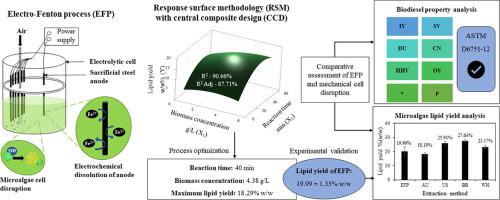Bioresource Technology ( IF 11.4 ) Pub Date : 2021-10-11 , DOI: 10.1016/j.biortech.2021.126110 Wanniarachchige Paramitha Sandani 1 , Malith Premaratne 1 , Thilini U Ariyadasa 1 , Jagath Kumara Premachandra 1

|
Electro-Fenton process (EFP) was studied as a potential cell disruption technique for recovery of lipids from wet biomass of the microalga Chlorella homosphaera. A novel approach of electrochemical dissolution of a sacrificial steel anode was used to provide Fe2+ required to initiate EFP and microalgae cell disruption. Response surface methodology (RSM) was employed to optimize the process parameters and maximize the lipid yield of EFP. The RSM model (R2 = 90.66%, Adj.R2 = 87.71%) showed that a maximum lipid yield of 18.29% could be obtained at 40 min reaction time and 4.38 g/L biomass concentration. Experimental validation resulted in a lipid yield of 19.99 ± 1.33%, which was significantly higher than wet lipid extraction without cell disruption. However, the lipid yield of EFP should be further improved to achieve comparable results to mechanical cell disruption methods. Nonetheless, biodiesel synthesized from lipids obtained via EFP conformed to the ASTM D6751-12 standard.
中文翻译:

采用牺牲钢阳极的电芬顿法破坏微藻细胞和湿脂提取的新策略
电芬顿法 (EFP) 被研究作为一种潜在的细胞破碎技术,用于从微藻小球藻的湿生物质中回收脂质。牺牲钢阳极电化学溶解的新方法用于提供启动 EFP 和微藻细胞破坏所需的Fe 2+。采用响应面方法 (RSM) 来优化工艺参数并使 EFP 的脂质产量最大化。RSM 模型(R 2 = 90.66%,Adj.R 2 = 87.71%) 表明在 40 分钟的反应时间和 4.38 g/L 的生物质浓度下可以获得 18.29% 的最大脂质产率。实验验证导致脂质产量为 19.99 ± 1.33%,显着高于没有细胞破坏的湿脂质提取。然而,应进一步提高 EFP 的脂质产量,以实现与机械细胞破碎方法相当的结果。尽管如此,由通过 EFP 获得的脂质合成的生物柴油符合 ASTM D6751-12 标准。



























 京公网安备 11010802027423号
京公网安备 11010802027423号